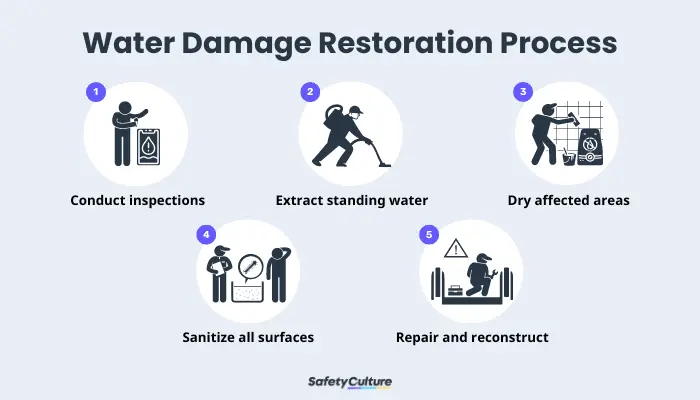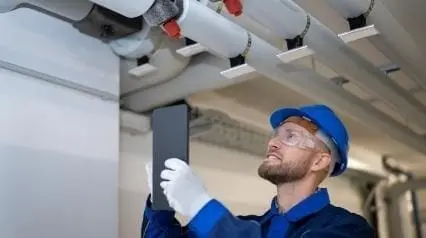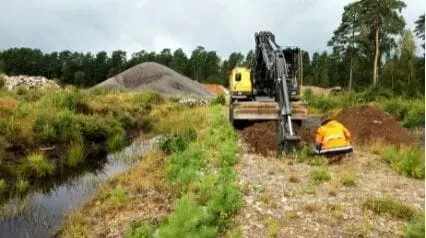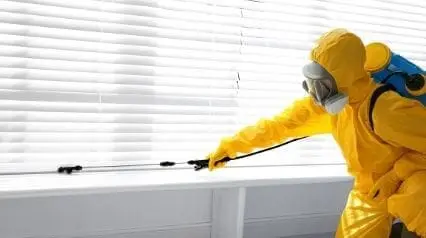What is Water Damage Restoration?
Water damage restoration is the process of returning the property’s condition to its original state before water intrusion. The process consists of inspection, extraction, dehumidification, sanitation, and reconstruction (if necessary). While water damage restoration usually does not require certification, it should ideally be performed by a water damage restoration specialist who is equipped with the right tools and knowledge to do so.
Why is Water Damage Restoration Important?
One of the reasons why water damage restoration is important is that structural damage can also be a result of water damage—not just a cause. Water damage and structural damage are closely connected and the presence of one often indicates the presence of the other. Walls, ceilings, and even floors can collapse due to water damage.
Ignoring water damage or not responding to it quickly enough can also pose long-term health risks from mold, bacteria, and pests. Minimizing the importance of water damage restoration not only diminishes the skill, knowledge, and experience required to do such work, but also significantly endangers the lives of building occupants.
What are the Major Causes of Water Damage?
Knowing what caused the problem you’re supposed to fix is just the first step to solving it. For water damage restoration specialists, being familiar with the major causes of water damage can help them easily locate the source when inspecting a property.
The major causes of water damage include the following:
- air conditioning unit condensation
- natural disasters (e.g., fire) and rainy weather
- rubber or PVC water supply lines
- broken household appliances
- clogged drains and gutters
- septic tank and sewer backups
- burst or leaking pipes
- old or faulty water heaters
- damaged sprinkler systems
- water overflow from toilets
- inoperative sump pumps
- inefficient roof water drainage
Aside from knowing where to look, water damage restoration specialists should also know what to look for. Water damage can still be present in areas that don’t contain or seemingly haven’t been affected by any of the major causes listed above. Therefore, restoration specialists should be able to spot the signs of water damage right away.
What are the Signs of Water Damage?
One of the main protocols of the water damage restoration process is the ability to spot the signs of water damage proactively.
The signs of water damage include the following:
- swollen or warped materials
- cracks on the ceiling or wall
- peeling or bubbling paint
- musty or damp odors
- sagging or soft spots
- structural damage
- puddles of water
- mold or mildew
- water stains
Water Damage Restoration Process
Specialists typically perform the whole water damage restoration process in 5 easy steps:

1. Conduct a Water Damage Inspection
A water damage inspection or water damage assessment is conducted by the specialist to identify the water source, the water contamination category, and the water damage class.
As discussed in a previous section, the water source is heavily related to the cause of water damage. However, in some cases, it may still be difficult to identify the water source, even while knowing the cause of water damage (e.g., flood water may seep into the property through multiple entry points). After identifying and stopping the flow of the water source, the specialist will identify the water contamination category:
| Name | White Water | Gray Water | Black Water |
| Category | 1 | 2 | 3 |
| Contamination Level | Little to None | Has Contaminants | Hazardous |
| Water Sources / Causes of Water Damage | Bathtubs, Sinks, Pipes, Water Heaters | Dishwashers and Washing Machines | Sewage, Toilets, Flooding |
Identifying the water contamination category will help the specialist decide on the scope and type of decontamination needed later on. The third part of the inspection is the identification of the water damage class:
| Class 1 | Class 2 | Class 3 | Class 4 | |
| Wet Porous Materials Percentage of Surface Area | Less than 5% | 5% to 40% | More than 40% | More than 40% |
| Low Evaporation Materials Moisture Absorption | Minimal | Minimal | Minimal | Significant |
Wet porous materials include carpet, gypsum board, fiber-fill insulation, Concrete Masonry Unit (CMU) and textiles. Low evaporation materials include plaster, wood, concrete, and masonry. Identifying the water damage class is important because it indicates the extent of drying and dehumidification needed later on.
Create your own Water Damage Restoration Checklist
Build from scratch or choose from our collection of free, ready-to-download, and customizable templates.
Browse Water Damage Restoration Checklists2. Remove Standing Water via Extraction
Especially crucial when a property has a flooded basement, removing the standing water (also known as stagnant water) is done through extraction. Extractors include industrial vacuums and submersible pumps. After all standing water is removed, surface water can be extracted through portable wet/dry vacuums. The specialist may also use a moisture meter or infrared thermal camera to uncover hidden pockets of saturation behind walls or underneath floorboards. Residual surface water may also still be present even after vacuuming.
3. Dry and Dehumidify Affected Areas
Similar to water extraction, the specialist will also use equipment such as heavy-duty fans (including air movers) and commercial-grade dehumidifiers to dry and dehumidify affected areas. Aside from using these tools, the specialist may also open windows and doors to increase air circulation. However, drying and dehumidification will generally take longer than water removal, especially if water damage is Class 3 or 4 and requires removing parts of walls and/or floors.
4. Clean and Sanitize All Surfaces
Before mold cleanup, the specialist needs to wear Personal Protective Equipment (PPE) such as an N-95 mask, gloves, googles, rubber boots, and disposable clothing or protective overalls. Similar to both extraction and dehumidification, the specialist will also use equipment such as a High Efficiency Particulate Air (HEPA) vacuum, an air scrubber, and other types of negative air machines during sanitation. If water damage is Category 3, all surfaces will need to be cleaned with an antimicrobial solution.
5. Repair and Reconstruct if Necessary
In the final part of water damage restoration, the specialist will remove unsalvageable parts (e.g., drywall below the flood line, low to medium density trim boards, carpet padding). Carpets can be deep cleaned, though they will more than likely need to be replaced. In some cases, wooden trim boards may be reused and drywall can be repaired, if the water damage isn’t Class 4 or Category 3. However, reconstruction may also be necessary, especially if the cause of the water damage is a natural disaster.
Although the process can be very complex at times, following some basic water damage restoration protocols can help ensure a thorough and effective restoration approach.
Integrate ESG principles into your operations
Drive sustainable growth and create long-term value with our ESG solutions.
Explore nowPerform Efficient Water Damage Restoration Process with SafetyCulture (formerly iAuditor)
SafetyCulture is a convenient inspection tool that water damage restoration specialists can use to document what’s happening on-site and efficiently do the following:
- Take and attach photos of water damage inspections and submit detailed reports to clients and insurance providers.
- Eliminate the entire hassle of printing out photos, stapling them to paper reports, typing up reports after an inspection, and sending completed reports through fax.
- Generate reports automatically after completing a water damage inspection and send them via PDF, Excel, Word, or shareable weblink.
- Perform water damage restoration quickly and efficiently using the SafetyCulture app on your mobile device, even while offline.
- Equip your team of specialists with the right tool to do the job well.
FAQs about Water Damage Restoration Process
Generally, a water damage restoration process can take anywhere from a few days to several weeks. The actual duration of each restoration, however, depends on factors such as the extent of the damage, the size of the affected area, if there’s an observed presence of mold or other contaminants, as well as the efficiency of the restoration process.
For minor water damage such as those in localized areas or a specific room in a home, the restoration process can take from several days to a week. For slightly bigger affected areas at home, the restoration can take from a whole week to two. For severe cases, however, such as flooding or significant water infiltration throughout the home, extensive restoration is required—which can take from several weeks to a few months.
Some of the things that need to be replaced as a result of water damage incidents are items such as damaged building materials, affected electrical components, furniture, insulation, and appliances and equipment. It’s important to consult with water damage restoration professionals who can assess the extent of the damage and provide guidance on which items can be salvaged and restored versus those that require replacement.
When dealing with significant or extensive water damage, it is highly recommended to consult a water damage restoration specialist. These professionals have the expertise and resources to handle the restoration process efficiently and effectively—allowing you to avoid further consequences and ensuring a successful outcome for you


